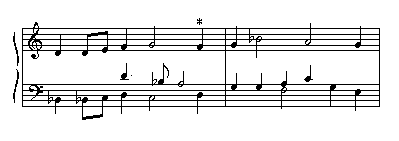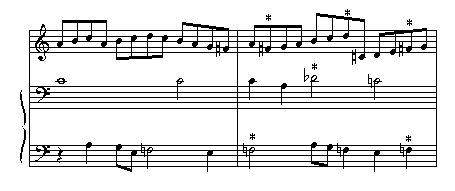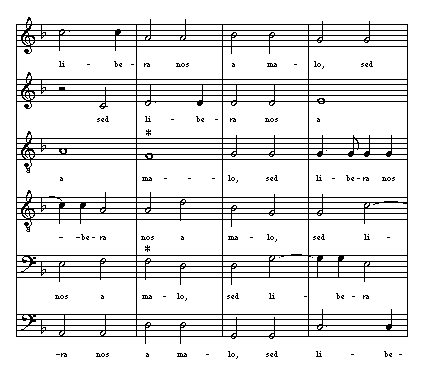
Introduction
(I) Specified chromatic inflections in vocal sources
(II) The theorists' statements> (III) Instrumental tablatures
first part
> second part
Italian lute tablatures
Two Italian sources of the early sixteenth century also contain exceptions to the attraction principle. One will find about ten cases in the tablature of Francesco Spinacino (1507), and four more in Vincenzo Capirola's (about 1517):
ex.: Francesco Spinacino, Tandernaken (after A. Agricola)

[See DISERTORI, Benvenuto, Le Frottole per canto e liuto intabulate da Franciscus Bossinensis, Milano, Ricordi, 1964, p. 199/2/1; other instances: p. 186/2/5, 188/2/1, 188/2/5, 189/2/1, 189/3/6, 192/3/2 (doubled subtonic), 218/3/4, 238/2/5, 242/2/2. All these ten passages have been checked on the facsimile: SPINACINO, Francesco, Intabolatura de Lauto: libro primo (secundo), Geneva, Minkoff, 1978, 233 p., with a foreword by François Lesure.]
But it should be mentioned that other passages of Spinacino's tablature appear to be quite absurd, especially in the pieces for two lutes:
ex.: Francesco Spinacino, Joli amours (after Joannes Ghiselin)

[Ibid., p. 205/2/4 (this passage as well has been checked against the facsimile).]
Italian intabulators often go on to make an arrangement of vocal pieces with many voices, in which cases they not unfrequently have to cope with the problem of the doubled subtonic (a feature characteristic of Franco-Flemish polyphony, which will be detailed later on), and of the concomitant simultaneous false relation. In most cases, they avoid the problem either by suppressing the doubled note, or less typically (in non-final cadences) by relinquishing the raising of the seventh degree, as in the following example:
ex.: Francesco da Milano, Pater noster (after Josquin)

[See NESS, Arthur J. (ed.), The Lute Music of Francesco Canova da Milano (1497-1543), Cambridge, Mass., Harvard University Press, 1970, p. 287/215-217. CHIESA, R. (ed.), Francesco da Milano (1497-1543), Opere complete per liuto, Milano, Suvini Zerboni, Vol. II: Intavolature di opere polifoniche vocali, p. 90/219-91/221.]
For comparison, I shall quote Josquin's original:
ex.: Josquin, Pater noster

[CHIESA, R. (ed.), op. cit., p. 90/219-91/221.]
By contrast, Valentin Bakfark, one of the greatest lute virtuosos of his time, uses the imperfect octave in a few cases of doubled subtonic. But all such instances are found in one and the same piece:
ex.: Valentin Bakfark, Benedicta à six (after Loyset Pieton)

[See KOCZIRZ, Adolf (ed.), Österreichische Lautenmusik im XVI. Jahrhundert : Hans Judenkünig, Hans Newsidler, Simon Gintzler, Valentin Greff Bakfark und Unika der Wiener Hofbibliothek, Wien, 1919 (=Denkmäler der Tonkunst in Österreich 37, Jg. XVIII/2), p. 75/30. Although he was a Hungarian by birth, Bakfark's works have come down to us mainly in Italian tablature notation.]
This formula appears as much as nine times in this piece, but in no other work by Bakfark that we have examined. Moreover, it should be noted that, on a lute, such an imperfect octave would not be as harsh as on an organ for example, owing to the fact that the strings of a lute cannot sustain notes for very long, and that the constituent notes of the above-quoted false octave are not properly speaking attacked simultaneously. Fingering difficulties could even cause the performer to leave the f natural in order to be able to play the following cadence formula (returning note) which includes the f sharp.
To sum up, the Italian lute tablatures sometimes make an exception to the attraction principle, but only at the very beginning of the sixteenth century. As for double-leading-note cadences, they are already virtually nonexistent in this repertory.
Other tablatures
Modal cadences are very rare in the other types of tablatures (French and German lute tablatures, Spanish vihuela and keyboard tablatures). The clearest exceptions appear in a transcription by the French lutenist Guillaume Morlaye (1552-58), based on an original vocal piece by Lupus:
ex.: Morlaye, Hierusalem luge [after Lupus]

[See RENAULT, M. (ed.), Guillaume Morlaye, oeuvres pour le luth, Paris, CNRS, 1980 (Corpus des luthistes français), p. 58/59; no less than eleven other instances may be found in this piece: p. 50/12, 53/60, 54/101, 56/12-13, 57/33, 57/45, 58/51, 59/77, 60/91, 61/106, 62/120.]
In this context, it may be of interest to note that Morlaye's publications often contain arrangements by foreign musicians, notably Julio da Modena, Narvaéz, Vindella, Valderrábano or Borrono. It cannot be excluded that the above-quoted "Hierusalem luge" originates in some other instrumental tradition, for example the German organ repertoire, where several such cases are to be found, as we have already seen.
Diego Pisador's vihuela tablature (1552) seems to be another special case. Indeed, it includes some modal cadences, as well as double- or single-leading-note cadences, and rather frequent imperfect octaves. From this point of view, it seems to resemble the tablatures of Sicher or (to a lesser extent) Kleber. But the other Spanish tablatures of the time (for vihuela or keyboard) do not share such characteristics. Besides, Pisador's musical ability has been questioned by some modern commentators, and he might well be the arranger so harshly criticized by the contemporary theorist Bermudo, who denounces the barbarisms contained in certain vihuela tablatures (whose author he does not name).[See STEVENSON, R., Juan Bermudo, The Hague, Martinus Nijhoff, 1960, p. 57, note 1; BERMUDO, Juan, Comiença el libro llamado declaracion de intrumentos musicales..., Osuna, 1555, fol. c., verso (bottom of the first column).]
Hence, apart from these two particular cases, which most probably cannot be considered as representative of the instrumental literature of their country at that time, modal cadences do not appear in Spanish and French tablatures, as well as in German lute tablatures.
Summing up, for the whole period previous to about 1560, modal tendencies are mainly to be found in a group of German organ tablatures (Buchner, Hör, Sicher, Kleber), as well as in some isolated Italian (Spinacino, Capirola), French (Morlaye) and Spanish tablatures (Pisador).
© Vincent Arlettaz
- last update: 27 December 2002 -